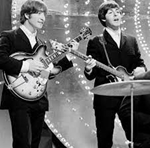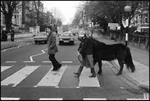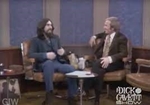- Register
- Log in to Tune-In
- Wishlist (0)
-
Shopping cart
(0)
You have no items in your shopping cart.
Beatles News

George Harrison said he wasn’t “brilliant” at taking care of his career. Maybe that was because he never considered himself in one his whole life. George never pursued a solo career.
He released All Things Must Pass as a reaction to leaving The Beatles. He had so many songs stockpiled that he had to release them just to move forward. When the triple album did well, he continued making music on his schedule. He didn’t like making music just because the record companies and fans wanted him to.
However, after releasing several albums through the years, George couldn’t deny that he had somewhat of a career and realized he wasn’t good at keeping it afloat.
Source: Hannah Wigandt/cheatsheet.com
details
If you’re a fan of a particular era of British rock ’n’ roll, this is the right year to be at the Telluride Film Festival. The festival’s opening day brought onetime photographer Anton Corbijn’s “Squaring the Circle,” which looked at the rock design company Hipgnosis through memories from Paul McCartney, Jimmy Page, Roger Waters, Noah Gallagher and many others. And it was followed the next afternoon by onetime photographer Mary McCartney’s “If These Walls Could Sing,” which looks at London’s Abbey Road recording studio through memories from, oh, Paul McCartney, Jimmy Page, Roger Waters, Noah Gallagher and many others.
Source: Steve Pond
details

John Lennon felt one of The Beatles‘ songs was an early heavy metal record. Paul McCartney felt the song was groundbreaking as well, although for different reasons. Notably, the song became a hit twice in the United Kingdom.
In the 1997 book Paul McCartney: Many Years From Now, Paul discussed The Beatles’ “Ticket to Ride.” “It was pretty much a work job that turned out quite well,” he said. “I think the interesting thing was a crazy ending: instead of ending like the previous verse, we changed the tempo. We picked up one of the lines, ‘My baby don’t care,’ but completely altered the melody.”
In Paul McCartney: Many Years From Now, Paul said “Ticket to Ride” was innovative. However, he did not claim it was an early heavy metal song.
Source: Matthew Trzcinski/cheatsheet.com
details
The first person who really got George Harrison interested in guitar wasn’t a rock musician. After hearing their music, George begged his mother, Louise, for a beginner’s guitar. Thankfully, she obliged.
After school every day, George turned on the radio. He listened to tunes from Jimmie Rodgers, Big Bill Broonzy, Slim Whitman, and various English music-hall numbers. However, Rodgers made George interested in guitar.
“And my father had some records, and he used to go away to sea, and he brought back this big wind-up gramophone and Jimmie Rodgers records. ‘Waiting for a Train,’ it was called, and ‘Blue Yodel.’ And so I always remember that from when I was a little kid of about eight or seven.
Source: Hannah Wigandt/cheatsheet.com
details
George Harrison often discussed his spiritual beliefs.
George Harrison said that political and spiritual leaders hadn’t impressed him.
Ravi Shankar was the first person who impressed George Harrison.
George Harrison had a reputation as the Quiet Beatle, but he wasn’t afraid to share his opinion, even if it was a bit harsh. During a photoshoot that Harrison clearly wasn’t happy to be a part of, he spoke about how difficult he was to impress. He said that being on the cover of a magazine didn’t mean much to him. He also shared that of all the musicians, politicians, and religious leaders he’d met in his life, only one had ever impressed him.
George Harrison often discussed his religious and spiritual beliefs
Harrison rose to global fame as a teenager, and by the time he was in his twenties, he felt weary of his popularity. For him, the antidote to this was spirituality.
Source: Emma McKee/cheatsheet.com
details
THE BEATLES star George Harrison became extremely nervous about being in public during the band's final few years together. Eventually, it got so bad he was having regular worries about being shot. Soon thereafter, he announced he had quit the band. Hauntingly, this was the exact method of how his bandmate, John Lennon, was murdered.
Harrison, who was the youngest member of the band, was known as the Quiet Beatle because he was less outspoken than the rest of the group.
This didn't mean he didn't stand up for himself in the Fab Four, but he was less likely to make flippant comments to the press - much like John Lennon did in the Philippines. While on tour in the country, Lennon announced that The Beatles were "bigger than Jesus". This controversial statement enraged Christians around the world.
David Acomba, who filmed Harrison's 1974 solo tour, explained this incident was the beginning of the star's fears.
Source: Callum Crumlish/express.co.uk
details
The three-time Oscar-winning 'Lord of the Rings' helmer received awards for directing and for outstanding documentary.
Peter Jackson won his first Emmys, for directing and for outstanding documentary, for The Beatles: Get Back docuseries, which debuted last year on Disney+.
“A big shout-out to the Beatles,” enthused Jackson. For best documentary, winners also included Paul McCartney, Ring Starr, Yoko Ono Lennon and Olivia Harrison.
Get Back is based on material shot in early 1969 for the Michael Lindsay-Hogg’s 1970 feature film Let It Be. Both picture and sound went through a meticulous restoration process, building on techniques developed to restore World War I footage in Jackson’s 2018 documentary, They Shall Not Grow Old. Accepting the directing Emmy, Jackson recognized Lindsay-Hogg’s work.
Source: Carolyn Giardina/hollywoodreporter.com
details
Mary McCartney didn’t want her new documentary about Abbey Road Studios to focus too much on her own family—her father, Paul McCartney, and her mother, the late Linda McCartney—their band Wings, or even The Beatles. She wanted If These Walls Could Sing to look beyond what she already knew and explore the countless other artists and iconic recordings connected with that legendary London recording space. But there’s no getting around it: The world knows Abbey Road Studios because The Beatles named their final album after it and because of that record’s famous cover image of John, Ringo, Paul, and George strolling through its adjacent crosswalk.
Source: Anthony Breznican/vanityfair.com
details
About 30 seconds into Dick Cavett's 1971 interview with George Harrison, we learn what he thinks of Yoko. Cavett tells George that Yoko sat in the same seat George is sitting in, and George jumps up in mock disgust. The audience claps and laughs. I guess they didn't like her much either. But then Harrison adds, "I saw the show, it was very nice."
He then goes on to promote John and Yoko's Christmas record, so perhaps everyone really loved each other. A bit later George reveals "the group had problems long before Yoko came along. Many problems."
He also says he doesn't remember much about the Beatles days: "It feels like a previous incarnation." Strange, considering the band broke up just a year earlier.
Source: Mark Frauenfelder/boingboing.net
details
Between February and April of 1968, The Beatles embarked on a transcendental meditation retreat and course with Maharishi Mahesh Yogi in Rishikesh, India. During their spiritual respite, the songs of their ninth album, The Beatles (the White Album), started taking form. John Lennon and Paul McCartney would often meet secretly to write in between meditative breaks, while George Harrison, who had been squeezing in typically two or more of his own songs on prior Beatles records, was also becoming a more prolific songwriter—even writing for other artists—as well as a musician, during this time.
Source: americansongwriter.com
details
Ever since The Beatles made Abbey Road their home in the early ’60s, the iconic studio has become a sacred spot, a holy ground for some of the most groundbreaking recordings of all time. Great English music is cemented into the history of the studio and continues to be coaxed out today. Acts like Radiohead, Pink Floyd, The Zombies, Florence + the Machine, and Oasis have all gone on to deliver career-making recordings while in Westminster.
Below, in no particular order, we’re going through 10 of the best songs recorded at the iconic studio. From The Beatles to Oasis let’s take a trip through the artists that have struck gold at Abbey Road.
1. “Come Together” (The Beatles)
Of course, we have to look at the Beatles’ swan song, Abbey Road. Across the album’s 17 tracks are a number of perennial Beatles hits. With “I Want You (She’s So Heavy),” “Here Comes The Sun,” “Carry That Weight, and “Come Together” amongst the tracklist, it almost reads more like a greatest hits album than a singular effort.
The latter track is the one we’ve chosen for this list, although many could be contenders. The opening bass riff o details

I arrived at the modest townhouse, opened my suitcase and carefully placed “Revolver” on the turntable – the vinyl had miraculously survived the trip from Boston. I listened to the Harrison written “Collector” in the living room where teenager George once stuck with Paul McCartney and John Lennon as the Quarrymen and then as the Beatles from 1960. legend has it Louise Harrison used to bring some whiskey to the boys when they rehearsed, so I had a drink in her honor while listening to records. Did I have misty eyes? Only the shot of young George on the coat knows for sure.
Source: Judy J. Beasley/apartmentsapart.com
details
THE BEATLES star George Harrison was forced to step in and make John Lennon change the lyrics of one raunchy song when he realised it would insult a friend of theirs. Lennon later publicly addressed the change, while Harrison claimed its lyrics were "ridiculous".
It was recently announced that The Beatles' seventh album, Revolver, will be getting a reissue in the coming months. Although the record is iconic, one of the band's most popular albums was one that followed: The White Album.
The band's 1968 record was their ninth album and included a collection of incredible tracks mainly written in India while the Fab Four were a Transcendental Meditation course.
One track left George Harrison frustrated, however.
Source: Callum Crumlish/express.co.uk
details

Last year, The Beatles: Get Back arrived on Disney+ with eight hours of mostly unseen footage of the Fab Four in their 1969 Let It Be sessions. Peter Jackson cleaned up a ton of behind-the-scenes moments of John Lennon, Paul McCartney, George Harrison and Ringo Starr, who were clearly having the time of their lives.
Almost a year on and McCartney has had a chance to see The Beatles: Get Back and recently gave a Q&A for fans on his official website.
One fan, also called Paul, said: “I just wanted to say thank you. Just like lockdown re-ignited my love of football, Get Back has re-ignited my love of The Beatles. Can I ask what part of the documentary bought the biggest smile to your face? Mine was you and Ringo playing piano together.”
McCartney, who turned 80 this year, replied: “There were quite a few smiles: me and John goofing around on ‘Two of Us’ acting like ventriloquists and singing through our teeth; me and John goofing around on ‘Bathroom Window’ where we start ringing Tuesday - “Hello Tuesday!” - that was nice. But the one that immediately comes to mind is John dancing - just seeing him dancing. It’s very cute, and he was actually a re
details

A 1958 Gibson Les Paul guitar that George Harrison purchased specifically to help secure the return of his prized 1957 Les Paul guitar, known as “Lucy,” after it had been stolen, is going up for bid as part of an auction scheduled for September 24.
Harrison was gifted “Lucy” by his friend Eric Clapton in 1967 and used it frequently during the last years of The Beatles. The guitar was stolen from George’s Beverly Hills home in 1973 and eventually purchased by a Los Angeles guitar shop, which in turn sold it to a Mexican musician named Michael Ochoa.
After Ochoa returned home with “Lucy,” Harrison tracked down the instrument. After some negotiating, George agreed to trade a sought-after 1958 Les Paul with a sunburst finish and a Fender Precision bass for his beloved guitar. Harrison purchased the ’58 Les Paul, now nicknamed the “Ransom” guitar, from Norman Harris, of L.A.’s Norman’s Rare Guitars shop.
Source: wdrv.com
details